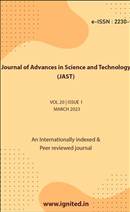The Elevation and Disturbance Gradent and the Distribution of Riparian Flora
DOI:
https://doi.org/10.29070/3kxnkk34Keywords:
riparian ecosystems, moderately moist plant communities, faunas, elevation gradient, disturbance gradient, distribution, physiography, transition zones, riparian forestsAbstract
Riparian ecosystems are comprised of moderately moist plant communities and the faunasthat are associated with them, and they are located between aquatic and more arid upland locations. Themain aim of the study is The Elevation and Disturbance Gradent and The Distribution of Riparian Flora. Ithas been considered the research area and physiography. The transition zones between terrestrial andaquatic habitats is riparian forests.Downloads
References
Urbanic, Gorazd&Politti, Emilio & Rodríguez-González, Patricia & Payne, Robin & Schook, Derek & Alves, Maria & Anđelković, Ana & Bruno, Daniel &Chilikova-Lubomirova, Mila &Lonardo, Sara &Egozi, Roey&Garófano Gómez, Virginia & Marques, Inês & González del Tánago, Marta & Gultekin, Yasar Selman &Gumiero, Bruna &Hellsten, Seppo &Hinkov, Georgi &Jakubínský, Jiří & Dufour, Simon. (2022). Riparian Zones—From Policy Neglected to Policy Integrated. Frontiers in Environmental Science. 10. 868527. 10.3389/fenvs.2022.868527.
Raphael, Antidius & Makarius, Lalika. (2022). The Potential of Riparian Forests in Anthropogenic Stressed River Ecosystems.
Rodríguez-González, Patricia & Abraham, Eleni & Aguiar, Francisca &Andreoli, Andrea &Baležentienė, Ligita& Berisha, Naim & Bernez, Ivan & Bruen, Michael & Bruno, Daniel &Camporeale, Carlo &Čarni, Andraž&Chilikova-Lubomirova, Mila &Corenblit, Dov &Ćušterevska, Renata & Doody, Tanya & England, Judy & Evette, André & Francis, Robert &Garófano Gómez, Virginia & Dufour, Simon. (2022). Bringing the margin to the focus: 10 challenges for riparian vegetation science and management. Wiley Interdisciplinary Reviews: Water. 1-14.
Srivastava, V.K.. (2007). River Ecology in India: Present Status and Future Research Strategy For Management and Conservation. Proceedings of the Indian National Science Academy. 73. 255-269.
Shandas, Vivek. (2007). An Empirical Study of Streamside Landowners' Interest in Riparian Conservation. National Research Council. 73. 10.1080/01944360708976151.
Naiman, Robert & Decamps, Henri & McClain, Michael. (2005). Riparia: Ecology, Conservation and Management of Streamside Communities. 10.1016/B978-012663315-3/50003-4.
Rawat, Gopal. (2005). Vegetation dynamics and management of Rhinoceros habitat in Duars of West Bengal: An ecological review. 28. 179-186.
Pusey, Bradley & Arthington, Angela. (2003). Importance of the Riparian Zone to the Conservation and Management of Freshwater Fish: A Review. Marine and Freshwater Research. 54. 10.1071/MF02041.
Baattrup-Pedersen A, Friberg N, Larsen SE, Riis T. 2005. The influence of channelization on riparian plant assemblages. Freshwater Biology 50:1248–1261.
Cosmas Mligo, Diversity and distribution pattern of riparian plant species in the Wami River system, Tanzania, Journal of Plant Ecology, Volume 10, Issue 2, 1 April 2017, Pages 259–270, https://doi.org/10.1093/jpe/rtw021






